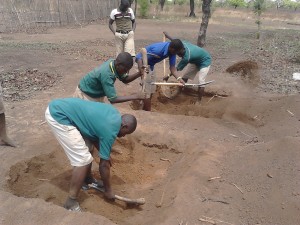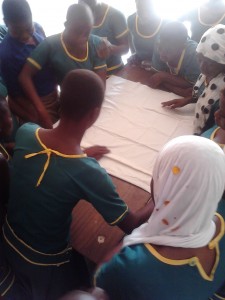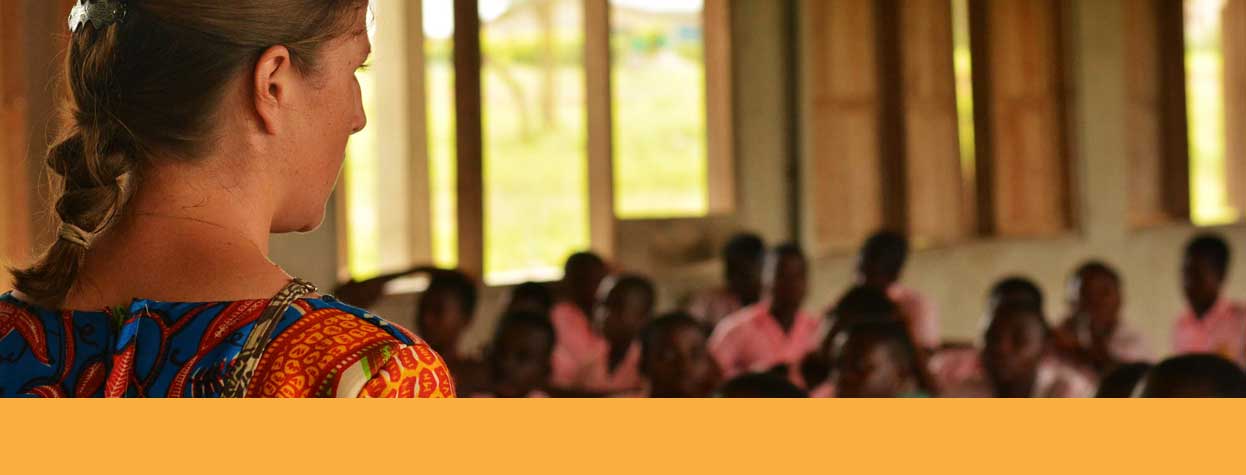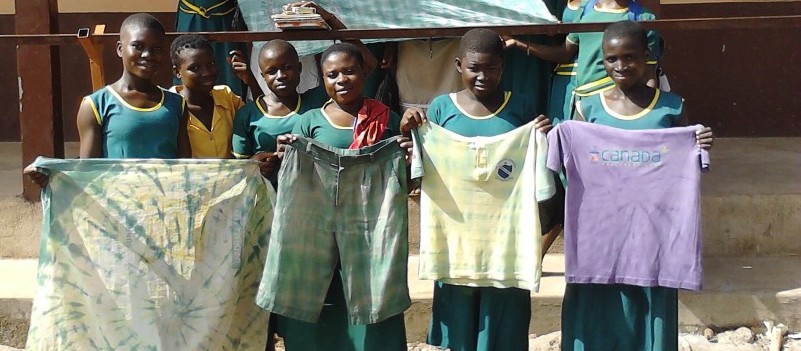As I sit under the shade of the neem tree, drinking from my bag of porridge, I can’t help but reflect on this wonderful day. It all started this morning as I was walking past the Form 1A classroom, headed for the office to write lesson notes for next week. I hear, “Madam, we have science!” I turn around and see two students leaning out of the window. They, in fact, did not have science during that period, but how could I resist an opportunity like that—students asking for extra science class? The students were ready and so willing to learn, but the teachers for both their first and second period were not teaching, so we spent two class periods reviewing food chains and playing fun games! For the food chain review session, students were divided into groups; each group was to come up with their own food chain, act out each organism in the lineup, and identify which were the producer and the various consumers. The students were creative and such good actors! They acted out grass and maize, rabbits and goats, lizards and hawks, zebras and lions, and distinguished between herbivores, carnivores, and omnivores. I am confident that the student engagement and activities such as these help the students remember food chains and organisms’ roles in balanced ecosystems long after the term ends. For the remaining unused classtime, we played games outside, and I was able to witness leaders emerge. Instead of me as the teacher leading the games as usual, a few students took initiative and asked to lead their fellow classmates in fun and laughter. They were just some silly games to the students, but for me, I saw much more than that happen.
At 10:20, the bellboy rang the bell to signal the start of break time. After the students filled their stomachs with some t-z (a maize ball) from their homes or rice from the market, the 4-H members went straight to work. During the program of the 4-H meeting held earlier in the week, we had learned about using compost fertilizer in the garden, and this morning we put that new knowledge to work. The students worked hard to break through that dry Northern Ghana soil to dig three compost pits, and then filled them with organic matter that was brought from students’ homes and also collected from around the school. After the school garden is planted in late May, we hope to harvest increased yields because the soil will be supplemented with extra nutrients that have come from the compost pits the students have created and will maintain themselves.
filled them with organic matter that was brought from students’ homes and also collected from around the school. After the school garden is planted in late May, we hope to harvest increased yields because the soil will be supplemented with extra nutrients that have come from the compost pits the students have created and will maintain themselves.
Shortly thereafter, I experienced a rewarding moment that did not come from an organized classroom or from within an official organizational gathering. I went back to visit the compost pits with three students accompanying me- Bawa, Ganiwu, and Zakaria. Each are JHS 1 students but not members of the 4-H club. When we got to the garden, they were asking me all kinds of questions about the pits we had dug, what we were putting inside, and why we were doing all of this. Their curiosity led to great discussion on the benefits compost brings to your garden as well as the simplicity of creating it at home. I watched as this conversation switched on a light bulb inside their minds, making my heart leap for joy inside my  chest. Their realization, that they can easily compost at home and harvest higher yields in their current farm or garden because of it, is how they will improve food security in their homes, which is the ultimate goal in agricultural education! I look forward to visiting these students at their homes to see the progress of their composting.
chest. Their realization, that they can easily compost at home and harvest higher yields in their current farm or garden because of it, is how they will improve food security in their homes, which is the ultimate goal in agricultural education! I look forward to visiting these students at their homes to see the progress of their composting.
Next was tie and dye time! This culture is saturated with beautiful, bright, patterned fabrics, and tie and dye patterns are among the fabrics that Ghanaians commonly wear. Every two weeks, Jimle 4-Hers practice teamwork, trial and error, risk-taking, and a whole lot of creativity to create new and unique fabrics. And every two weeks, I get to witness their faces light up as they pull their finished products out of the dye. Today was no exception. The students experimented with new methods of tying the fabric, and utilizing multiple colors within one fabric. While the students are tying up their various shirts, handkerchiefs, and other cloths, dipping them into the dye, and enjoying each others’ company while waiting for the color to set, they are developing skills that can be used as an entrepreneurial opportunity after they finish their education.
After the freshly tied and dyed had fabric had dried and the students had all headed home, Namow, the door-to-door porridge salesgirl of Jimle, showed up at my house; she knows she can always get a sale from me. Here I am, under the neem tree, and I reflect on the fact that some days are difficult; there are days that I question my effectiveness and impact. Those days are inevitable. But then there are days like today. Days like today that help me forget all about the slow days. Days like today that I observe the amount of potential these students possess and the bright futures they have ahead of them. It is because of my students that I experience such joy, and they are what make living in rural Northern Ghana so crazy and so worth it.
Dianne DeVos received a bachelor and masters degree in Agribusiness from Texas Tech University. Before becoming an AgriCorps Member, Dianne raised dairy cattle and studied agriculture in Ethiopia and Brazil.


